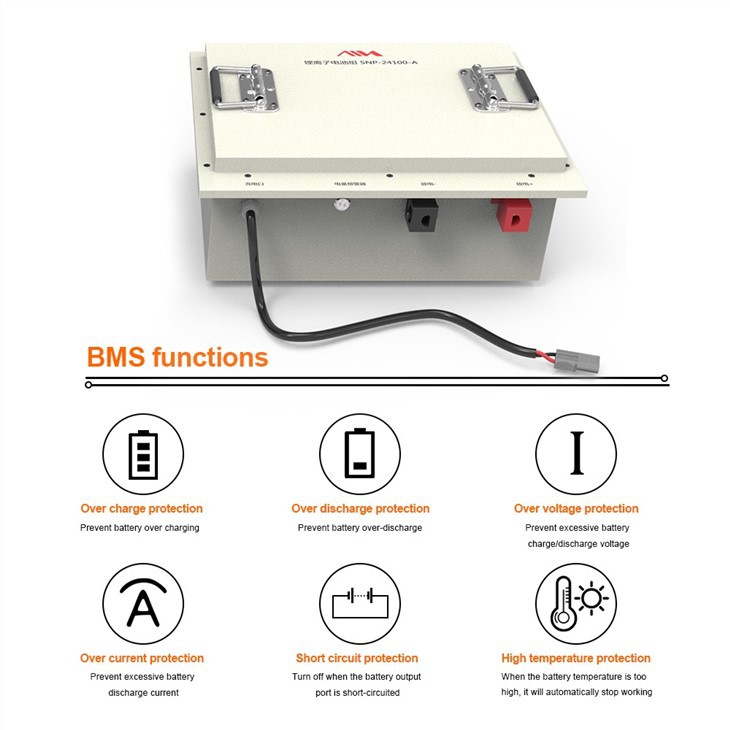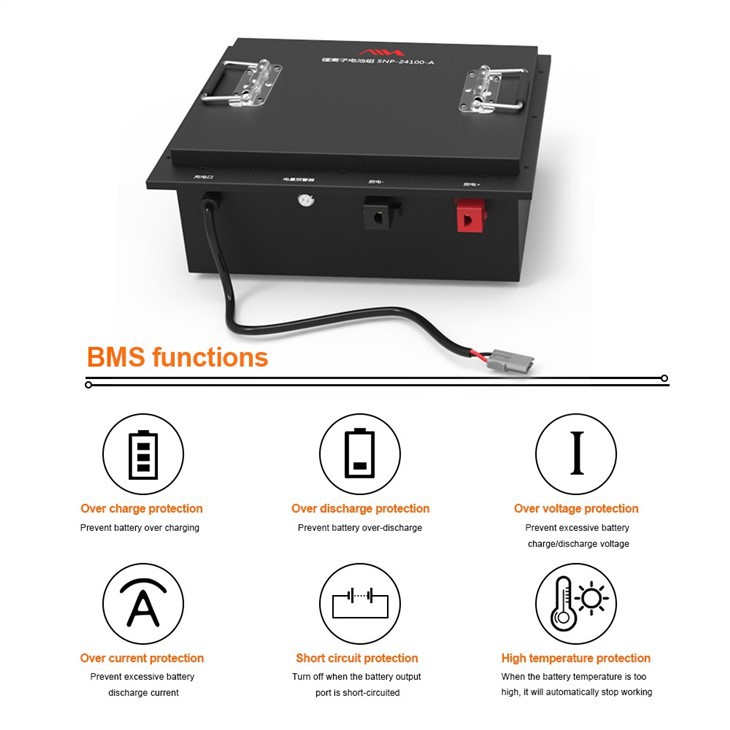Hey there! As an AGV battery supplier, I often get asked about the charging voltage tolerance of AGV batteries. It's a crucial topic, and today, I'm gonna break it down for you.
First off, let's understand what AGV batteries are. Automated Guided Vehicles (AGVs) are self - navigating vehicles used in various industries like warehouses, manufacturing plants, and logistics centers. These vehicles rely on batteries to operate, and the charging voltage tolerance plays a huge role in their performance and lifespan.
The charging voltage tolerance of an AGV battery refers to the acceptable range of voltage within which the battery can be safely and effectively charged. Different types of AGV batteries have different charging voltage tolerances. The most common types of batteries used in AGVs are lead - acid batteries, lithium - ion batteries (especially LiFePO4), and nickel - cadmium batteries.
Lead - acid Batteries
Lead - acid batteries have been around for a long time and are still widely used in some AGV applications. The charging voltage tolerance for a typical lead - acid battery is relatively narrow. For a 12 - volt lead - acid battery, the charging voltage usually ranges from about 13.8 to 14.4 volts. If the charging voltage goes too high, say above 14.4 volts for an extended period, it can cause overcharging. Overcharging leads to gassing, where water in the battery electrolyte is broken down into hydrogen and oxygen gases. This not only reduces the battery's electrolyte level but can also damage the battery plates over time. On the other hand, if the charging voltage is too low, below 13.8 volts, the battery may not be fully charged, which will reduce its capacity and the AGV's operating time.
Lithium - ion (LiFePO4) Batteries
LiFePO4 batteries are becoming increasingly popular in AGV applications due to their many advantages such as high energy density, long cycle life, and better safety compared to other lithium - ion chemistries. The charging voltage tolerance for a LiFePO4 battery is different from that of lead - acid batteries. For a 24 - volt LiFePO4 battery, the charging voltage typically ranges from 25.2 to 29.4 volts.
One of the great things about LiFePO4 batteries is that they are more tolerant of overcharging compared to other lithium - ion chemistries. However, it's still important to stay within the recommended charging voltage range. If the charging voltage exceeds 29.4 volts, it can cause the battery to overheat and potentially damage the battery cells. A voltage lower than 25.2 volts during charging may result in incomplete charging, which can reduce the battery's performance and lifespan.
We offer some great LiFePO4 battery options. Check out our Golf Cart EV Battery 24V 100Ah Rechargeable Deep Cycle Lithium Iron Phosphate LiFePO4 Batteries. These batteries are designed to provide reliable power for your AGV or other electric vehicles. Also, our Sweeper Robot 24V 100ah Lifepo4 Battery is perfect for AGV sweepers. And if you need a customized solution, we have the Customized LiFePO4 24V 50Ah 100Ah Floor Cleaning Machine Battery Operated Floor Sweeper Battery.
Nickel - cadmium Batteries
Nickel - cadmium (Ni - Cd) batteries were once very popular in AGV applications but are less common now due to environmental concerns. The charging voltage tolerance for a Ni - Cd battery is also specific. For a 12 - volt Ni - Cd battery, the charging voltage usually ranges from about 14.4 to 15.6 volts. Overcharging a Ni - Cd battery can cause a phenomenon called the "memory effect," where the battery "remembers" the partial charge cycles and loses its full capacity. To avoid this, it's important to charge the Ni - Cd battery within the recommended voltage range.
Factors Affecting Charging Voltage Tolerance
Several factors can affect the charging voltage tolerance of an AGV battery.
Battery Temperature
Battery temperature has a significant impact on the charging voltage tolerance. In general, as the battery temperature increases, the charging voltage tolerance decreases. For example, in a high - temperature environment, a LiFePO4 battery may not be able to tolerate as high a charging voltage as it can at room temperature. High temperatures can accelerate chemical reactions inside the battery, and if combined with a high charging voltage, it can lead to faster degradation of the battery.
Battery Age and State of Health
As a battery ages, its charging voltage tolerance may change. An older battery may have a more narrow charging voltage tolerance compared to a new one. Also, if a battery has been damaged or is in a poor state of health, its ability to handle different charging voltages may be reduced. For instance, a battery with damaged cells may not be able to tolerate the normal charging voltage range and may require a more conservative charging approach.
Charging Rate
The charging rate, also known as the C - rate, can affect the charging voltage tolerance. A higher charging rate means that more current is being delivered to the battery during charging. This can cause the battery's internal resistance to heat up, which in turn affects the charging voltage tolerance. In general, a higher charging rate may require a more careful control of the charging voltage to stay within the battery's tolerance.
Importance of Staying within the Charging Voltage Tolerance
Staying within the charging voltage tolerance is crucial for several reasons.


Battery Lifespan
As mentioned earlier, overcharging or undercharging a battery due to an incorrect charging voltage can significantly reduce the battery's lifespan. By keeping the charging voltage within the acceptable range, you can ensure that the battery lasts longer and provides reliable performance over time.
Battery Performance
A battery that is charged within its voltage tolerance will perform better. It will have a higher capacity, which means that the AGV can operate for a longer time on a single charge. This is especially important in applications where the AGV needs to run continuously for long periods, such as in a busy warehouse.
Safety
Operating a battery outside of its charging voltage tolerance can pose safety risks. Overcharging can cause the battery to overheat, which may lead to thermal runaway in some cases, especially in lithium - ion batteries. Thermal runaway is a dangerous situation where the battery's temperature rises uncontrollably, which can result in fire or explosion.
How to Ensure Proper Charging Voltage
To ensure that the AGV battery is charged within its voltage tolerance, it's important to use a proper charger. A good charger should be able to sense the battery's voltage and adjust the charging process accordingly. Many modern chargers are designed with built - in voltage regulators and charge controllers that can automatically stop charging when the battery reaches the upper limit of its charging voltage tolerance.
Regular battery monitoring is also essential. You can use battery management systems (BMS) to monitor the battery's voltage, temperature, and state of charge. The BMS can provide real - time information about the battery's condition and can alert you if the charging voltage is approaching the limits of the battery's tolerance.
Conclusion
In conclusion, understanding the charging voltage tolerance of an AGV battery is essential for anyone involved in AGV operations. Different types of batteries have different charging voltage tolerances, and several factors can affect these tolerances. By staying within the charging voltage tolerance, you can ensure the battery's longevity, performance, and safety.
If you're in the market for high - quality AGV batteries with proper charging voltage management, we're here to help. We offer a wide range of AGV batteries, including the Golf Cart EV Battery 24V 100Ah Rechargeable Deep Cycle Lithium Iron Phosphate LiFePO4 Batteries, Sweeper Robot 24V 100ah Lifepo4 Battery, and Customized LiFePO4 24V 50Ah 100Ah Floor Cleaning Machine Battery Operated Floor Sweeper Battery. If you have any questions or are interested in purchasing our AGV batteries, feel free to reach out to us for a procurement discussion.
References
- Linden, D., & Reddy, T. B. (2002). Handbook of Batteries. McGraw - Hill.
- Berndt, D. (2011). Batteries for Utility Energy Storage. Wiley.




